Yifan Zhang
University of Nottingham Ningbo China
Higher-order Linear Attention
Oct 31, 2025Abstract:The quadratic cost of scaled dot-product attention is a central obstacle to scaling autoregressive language models to long contexts. Linear-time attention and State Space Models (SSMs) provide scalable alternatives but are typically restricted to first-order or kernel-based approximations, which can limit expressivity. We introduce Higher-order Linear Attention (HLA), a causal, streaming mechanism that realizes higher interactions via compact prefix sufficient statistics. In the second-order case, HLA maintains a constant-size state and computes per-token outputs in linear time without materializing any $n \times n$ matrices. We give closed-form streaming identities, a strictly causal masked variant using two additional summaries, and a chunk-parallel training scheme based on associative scans that reproduces the activations of a serial recurrence exactly. We further outline extensions to third and higher orders. Collectively, these results position HLA as a principled, scalable building block that combines attention-like, data-dependent mixing with the efficiency of modern recurrent architectures. Project Page: https://github.com/yifanzhang-pro/HLA.
ExpertFlow: Adaptive Expert Scheduling and Memory Coordination for Efficient MoE Inference
Oct 30, 2025Abstract:The expansion of large language models is increasingly limited by the constrained memory capacity of modern GPUs. To mitigate this, Mixture-of-Experts (MoE) architectures activate only a small portion of parameters during inference, significantly lowering both memory demand and computational overhead. However, conventional MoE inference approaches, which select active experts independently at each layer, often introduce considerable latency because of frequent parameter transfers between host and GPU memory. In addition, current cross-layer prediction strategies, which are typically based on fixed steps, lack adaptability across different hardware platforms and workloads, thereby reducing their robustness and effectiveness. To address these challenges, we present ExpertFlow, a runtime system for MoE inference that combines adaptive expert prefetching and cache-aware routing. ExpertFlow continuously adjusts its prediction horizon for expert activation by leveraging runtime statistics such as transfer bandwidth, parameter dimensionality, and model feedback signals. Furthermore, it incorporates a hybrid cross-layer prediction scheme that fuses pregating information with intermediate computational states to anticipate future expert needs. By adaptively refining prefetching decisions and aligning them with actual usage behavior, ExpertFlow effectively decreases cache misses and removes latency caused by expert swap-ins. Our evaluation demonstrates that ExpertFlow reduces model stall time to less than 0.1% of the baseline, highlighting its capability to optimize MoE inference under stringent memory constraints.
Language Server CLI Empowers Language Agents with Process Rewards
Oct 27, 2025Abstract:Large language models routinely hallucinate APIs and mislocalize edits, while language servers compute verified, IDE-grade facts about real code. We present Lanser-CLI, a CLI-first orchestration layer that pins and mediates a Language Server Protocol (LSP) server for coding agents and CI, exposing deterministic, replayable workflows. Our position is that language servers provide not only structural information (definitions, references, types, diagnostics) but also an actionable process reward: machine-checked, step-wise signals that align an agent's planning loop with program reality. In this work, Lanser-CLI contributes: (i) a robust addressing scheme beyond brittle "file:line:col" via a Selector DSL (symbolic, AST-path, and content-anchored selectors) with a principled relocation algorithm; (ii) deterministic Analysis Bundles that normalize Language Server responses and capture environment/capability metadata with stable content hashes; (iii) a safety envelope for mutating operations (rename, code actions) with preview, workspace jails, and Git-aware, transactional apply; and (iv) a process-reward functional derived from Language Server facts (diagnostic deltas, disambiguation confidence, and safe-apply checks) that is computable online and replayable offline. We formalize determinism under frozen snapshots and establish a monotonicity property for the process reward, making it suitable for process supervision and counterfactual analysis. Project Page: https://github.com/yifanzhang-pro/lanser-cli
oMeBench: Towards Robust Benchmarking of LLMs in Organic Mechanism Elucidation and Reasoning
Oct 09, 2025Abstract:Organic reaction mechanisms are the stepwise elementary reactions by which reactants form intermediates and products, and are fundamental to understanding chemical reactivity and designing new molecules and reactions. Although large language models (LLMs) have shown promise in understanding chemical tasks such as synthesis design, it is unclear to what extent this reflects genuine chemical reasoning capabilities, i.e., the ability to generate valid intermediates, maintain chemical consistency, and follow logically coherent multi-step pathways. We address this by introducing oMeBench, the first large-scale, expert-curated benchmark for organic mechanism reasoning in organic chemistry. It comprises over 10,000 annotated mechanistic steps with intermediates, type labels, and difficulty ratings. Furthermore, to evaluate LLM capability more precisely and enable fine-grained scoring, we propose oMeS, a dynamic evaluation framework that combines step-level logic and chemical similarity. We analyze the performance of state-of-the-art LLMs, and our results show that although current models display promising chemical intuition, they struggle with correct and consistent multi-step reasoning. Notably, we find that using prompting strategy and fine-tuning a specialist model on our proposed dataset increases performance by 50% over the leading closed-source model. We hope that oMeBench will serve as a rigorous foundation for advancing AI systems toward genuine chemical reasoning.
HyP-ASO: A Hybrid Policy-based Adaptive Search Optimization Framework for Large-Scale Integer Linear Programs
Sep 19, 2025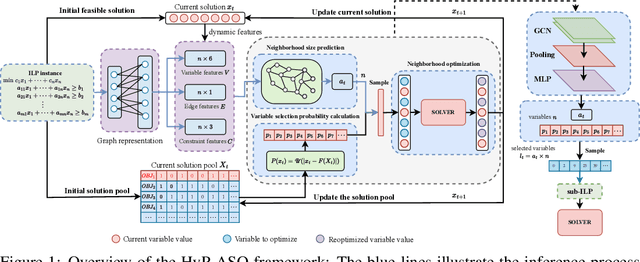

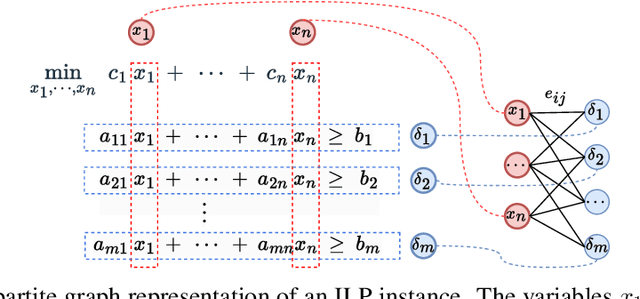

Abstract:Directly solving large-scale Integer Linear Programs (ILPs) using traditional solvers is slow due to their NP-hard nature. While recent frameworks based on Large Neighborhood Search (LNS) can accelerate the solving process, their performance is often constrained by the difficulty in generating sufficiently effective neighborhoods. To address this challenge, we propose HyP-ASO, a hybrid policy-based adaptive search optimization framework that combines a customized formula with deep Reinforcement Learning (RL). The formula leverages feasible solutions to calculate the selection probabilities for each variable in the neighborhood generation process, and the RL policy network predicts the neighborhood size. Extensive experiments demonstrate that HyP-ASO significantly outperforms existing LNS-based approaches for large-scale ILPs. Additional experiments show it is lightweight and highly scalable, making it well-suited for solving large-scale ILPs.
Exploring Polyglot Harmony: On Multilingual Data Allocation for Large Language Models Pretraining
Sep 19, 2025Abstract:Large language models (LLMs) have become integral to a wide range of applications worldwide, driving an unprecedented global demand for effective multilingual capabilities. Central to achieving robust multilingual performance is the strategic allocation of language proportions within training corpora. However, determining optimal language ratios is highly challenging due to intricate cross-lingual interactions and sensitivity to dataset scale. This paper introduces Climb (Cross-Lingual Interaction-aware Multilingual Balancing), a novel framework designed to systematically optimize multilingual data allocation. At its core, Climb introduces a cross-lingual interaction-aware language ratio, explicitly quantifying each language's effective allocation by capturing inter-language dependencies. Leveraging this ratio, Climb proposes a principled two-step optimization procedure--first equalizing marginal benefits across languages, then maximizing the magnitude of the resulting language allocation vectors--significantly simplifying the inherently complex multilingual optimization problem. Extensive experiments confirm that Climb can accurately measure cross-lingual interactions across various multilingual settings. LLMs trained with Climb-derived proportions consistently achieve state-of-the-art multilingual performance, even achieving competitive performance with open-sourced LLMs trained with more tokens.
Gradient-Attention Guided Dual-Masking Synergetic Framework for Robust Text-based Person Retrieval
Sep 11, 2025Abstract:Although Contrastive Language-Image Pre-training (CLIP) exhibits strong performance across diverse vision tasks, its application to person representation learning faces two critical challenges: (i) the scarcity of large-scale annotated vision-language data focused on person-centric images, and (ii) the inherent limitations of global contrastive learning, which struggles to maintain discriminative local features crucial for fine-grained matching while remaining vulnerable to noisy text tokens. This work advances CLIP for person representation learning through synergistic improvements in data curation and model architecture. First, we develop a noise-resistant data construction pipeline that leverages the in-context learning capabilities of MLLMs to automatically filter and caption web-sourced images. This yields WebPerson, a large-scale dataset of 5M high-quality person-centric image-text pairs. Second, we introduce the GA-DMS (Gradient-Attention Guided Dual-Masking Synergetic) framework, which improves cross-modal alignment by adaptively masking noisy textual tokens based on the gradient-attention similarity score. Additionally, we incorporate masked token prediction objectives that compel the model to predict informative text tokens, enhancing fine-grained semantic representation learning. Extensive experiments show that GA-DMS achieves state-of-the-art performance across multiple benchmarks.
Adapt in the Wild: Test-Time Entropy Minimization with Sharpness and Feature Regularization
Sep 05, 2025Abstract:Test-time adaptation (TTA) may fail to improve or even harm the model performance when test data have: 1) mixed distribution shifts, 2) small batch sizes, 3) online imbalanced label distribution shifts. This is often a key obstacle preventing existing TTA methods from being deployed in the real world. In this paper, we investigate the unstable reasons and find that the batch norm layer is a crucial factor hindering TTA stability. Conversely, TTA can perform more stably with batch-agnostic norm layers, i.e., group or layer norm. However, we observe that TTA with group and layer norms does not always succeed and still suffers many failure cases, i.e., the model collapses into trivial solutions by assigning the same class label for all samples. By digging into this, we find that, during the collapse process: 1) the model gradients often undergo an initial explosion followed by rapid degradation, suggesting that certain noisy test samples with large gradients may disrupt adaptation; and 2) the model representations tend to exhibit high correlations and classification bias. To address this, we first propose a sharpness-aware and reliable entropy minimization method, called SAR, for stabilizing TTA from two aspects: 1) remove partial noisy samples with large gradients, 2) encourage model weights to go to a flat minimum so that the model is robust to the remaining noisy samples. Based on SAR, we further introduce SAR^2 to prevent representation collapse with two regularizers: 1) a redundancy regularizer to reduce inter-dimensional correlations among centroid-invariant features; and 2) an inequity regularizer to maximize the prediction entropy of a prototype centroid, thereby penalizing biased representations toward any specific class. Promising results demonstrate that our methods perform more stably over prior methods and are computationally efficient under the above wild test scenarios.
Single Agent Robust Deep Reinforcement Learning for Bus Fleet Control
Aug 28, 2025Abstract:Bus bunching remains a challenge for urban transit due to stochastic traffic and passenger demand. Traditional solutions rely on multi-agent reinforcement learning (MARL) in loop-line settings, which overlook realistic operations characterized by heterogeneous routes, timetables, fluctuating demand, and varying fleet sizes. We propose a novel single-agent reinforcement learning (RL) framework for bus holding control that avoids the data imbalance and convergence issues of MARL under near-realistic simulation. A bidirectional timetabled network with dynamic passenger demand is constructed. The key innovation is reformulating the multi-agent problem into a single-agent one by augmenting the state space with categorical identifiers (vehicle ID, station ID, time period) in addition to numerical features (headway, occupancy, velocity). This high-dimensional encoding enables single-agent policies to capture inter-agent dependencies, analogous to projecting non-separable inputs into a higher-dimensional space. We further design a structured reward function aligned with operational goals: instead of exponential penalties on headway deviations, a ridge-shaped reward balances uniform headways and schedule adherence. Experiments show that our modified soft actor-critic (SAC) achieves more stable and superior performance than benchmarks, including MADDPG (e.g., -430k vs. -530k under stochastic conditions). These results demonstrate that single-agent deep RL, when enhanced with categorical structuring and schedule-aware rewards, can effectively manage bus holding in non-loop, real-world contexts. This paradigm offers a robust, scalable alternative to MARL frameworks, particularly where agent-specific experiences are imbalanced.
Optimizing Multi-Modal Trackers via Sensitivity-aware Regularized Tuning
Aug 24, 2025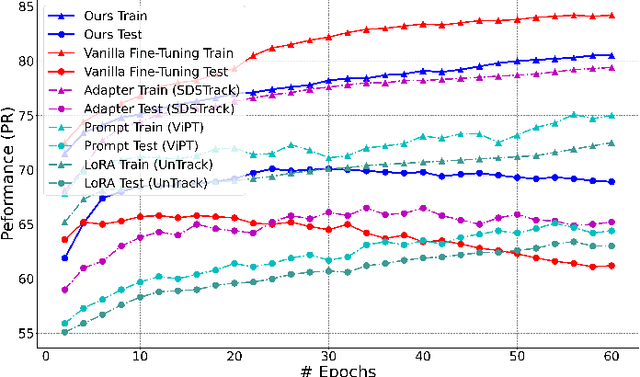
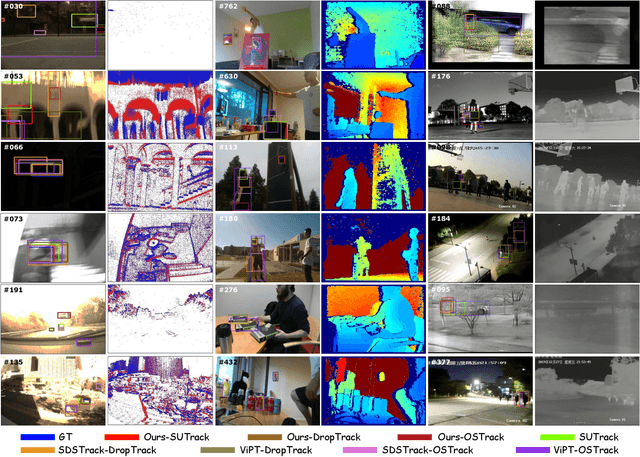
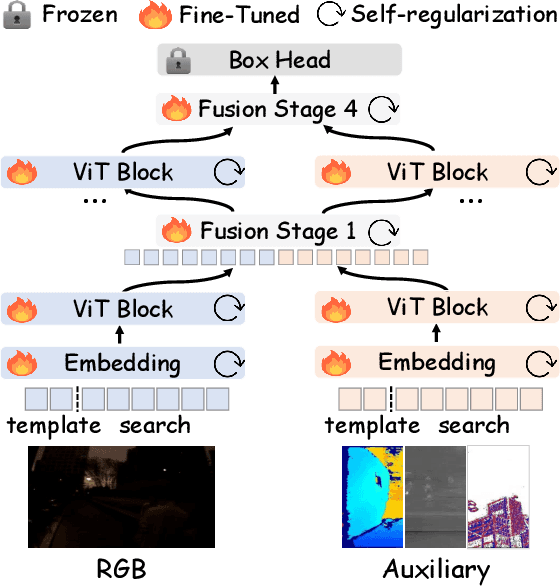

Abstract:This paper tackles the critical challenge of optimizing multi-modal trackers by effectively adapting the pre-trained models for RGB data. Existing fine-tuning paradigms oscillate between excessive freedom and over-restriction, both leading to a suboptimal plasticity-stability trade-off. To mitigate this dilemma, we propose a novel sensitivity-aware regularized tuning framework, which delicately refines the learning process by incorporating intrinsic parameter sensitivities. Through a comprehensive investigation from pre-trained to multi-modal contexts, we identify that parameters sensitive to pivotal foundational patterns and cross-domain shifts are primary drivers of this issue. Specifically, we first analyze the tangent space of pre-trained weights to measure and orient prior sensitivities, dedicated to preserving generalization. Then, we further explore transfer sensitivities during the tuning phase, emphasizing adaptability and stability. By incorporating these sensitivities as regularization terms, our method significantly enhances the transferability across modalities. Extensive experiments showcase the superior performance of the proposed method, surpassing current state-of-the-art techniques across various multi-modal tracking. The source code and models will be publicly available at https://github.com/zhiwen-xdu/SRTrack.
 Add to Chrome
Add to Chrome Add to Firefox
Add to Firefox Add to Edge
Add to Edge